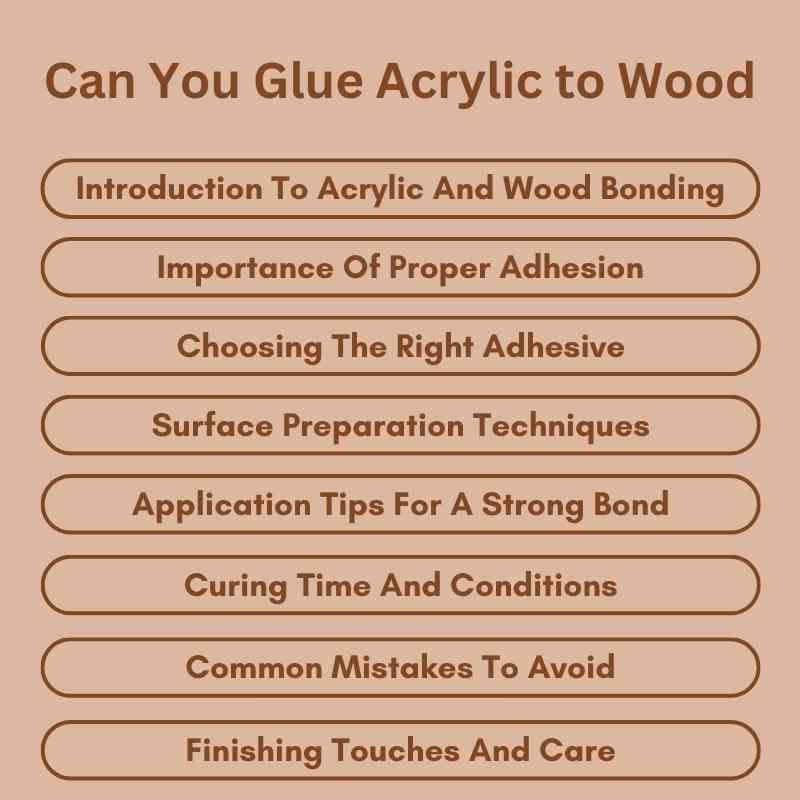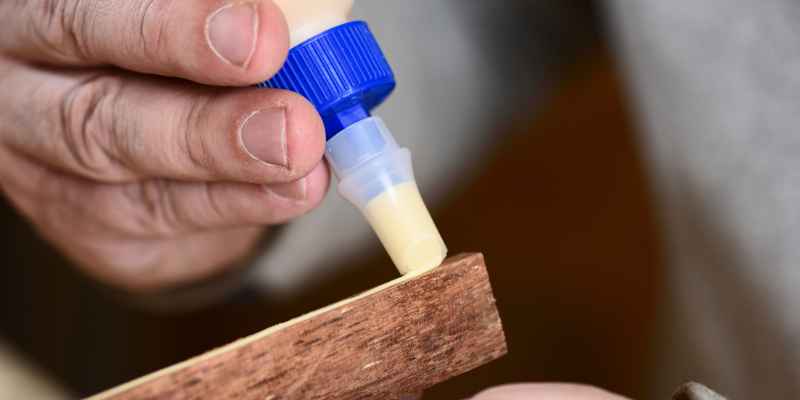Yes, you can glue acrylic to wood. Use a strong adhesive like cyanoacrylate or epoxy for the best results.
Acrylic and wood are popular materials used in various projects, from crafts to furniture design. Many DIY enthusiasts and professionals often seek effective ways to bond these materials. Proper adhesion is crucial for ensuring durability and aesthetic appeal. While acrylic is a versatile plastic, wood offers warmth and texture.
Choosing the right adhesive can make all the difference in achieving a strong bond. Understanding the properties of both materials helps in selecting the best gluing method. This guide explores effective techniques and tips to successfully glue acrylic to wood, ensuring your projects stand the test of time.
Introduction To Acrylic And Wood Bonding
Acrylic is a clear plastic that is strong and lightweight. It is often used in signs and displays. Its smooth surface makes it easy to clean and maintain.
Wood is a natural material with unique properties. Different types of wood have different strengths. Some woods can absorb moisture, which may affect bonding.
Choosing the right glue is very important. Not all adhesives work well with both materials. Use a glue that is specifically made for acrylic and wood.
Surface preparation is key for a strong bond. Clean both surfaces to remove dust and oils. This helps the glue stick better and last longer.

Importance Of Proper Adhesion
Proper adhesion between acrylic and wood is very important. Durability concerns arise when the bond is weak. A strong bond ensures that the materials stay together for a long time.
Using the right glue can help avoid these issues. Aesthetics and finish quality also depend on the adhesive used. Poor glue choices can lead to visible seams. This can ruin the look of your project.
Choose a clear-drying adhesive for a better finish. It helps maintain the beauty of both materials. A good bond also prevents peeling or chipping over time.
Choosing The Right Adhesive
Choosing the right adhesive is key for bonding acrylic to wood. Epoxy resins are strong and durable. They create a solid bond. This option is great for heavy-duty tasks.
Cyanoacrylate glue, often known as super glue, works quickly. It is perfect for small projects. Just apply a small amount for a fast hold.
Polyurethane adhesives are flexible and water-resistant. They expand as they dry, filling gaps well. This makes them ideal for outdoor use.
Surface Preparation Techniques
Clean the surfaces before gluing acrylic to wood. Use a mild soap and water solution. Rinse well to remove soap residue. Dry the surfaces completely with a clean cloth.
De-greasing is important for strong bonds. Use isopropyl alcohol or a suitable cleaner. Apply it with a lint-free cloth to remove oils and dirt.
Sanding helps improve adhesion. Lightly sand the wood surface with fine-grit sandpaper. Make sure to sand the acrylic edges too. This creates a rough surface for better glue grip.
Always clean dust after sanding. A clean surface ensures a stronger bond. Take your time with this step for best results.
Application Tips For A Strong Bond
To ensure a strong bond between acrylic and wood, apply the adhesive evenly. Use a brush or a spreader for best results. Make sure to cover the entire area for a solid connection.
Clamping is very important for effective bonding. Use clamps to hold the acrylic and wood together. This keeps them aligned while the adhesive sets. Check the manufacturer’s instructions for the recommended clamping time.
Curing Time And Conditions
The curing time for gluing acrylic to wood depends on temperature and humidity. Ideal conditions speed up the process. Warm temperatures help the glue set faster. High humidity can slow down curing time.
Maintaining a consistent temperature is crucial. A range between 65°F and 75°F is best. Avoid cold or damp environments. They can lead to weak bonds.
Time management is also important. Allow at least 24 hours for the glue to cure completely. Check the manufacturer’s instructions for specific guidance. This ensures a strong, lasting bond between the materials.
Common Mistakes To Avoid
Insufficient surface preparation can lead to weak bonds. Always clean the surfaces well. Remove dust and grease before applying glue.
Overapplication of glue is a common mistake. Using too much glue can create a mess. It may also weaken the bond between the materials.
Ignoring manufacturer’s instructions can result in poor results. Always read the label carefully. Follow the recommended drying times and application techniques.
Finishing Touches And Care
Sanding the edges of acrylic and wood can improve the bond. Use fine-grit sandpaper for a smooth finish. This helps the glue stick better and makes it look neat.
Maintaining the bond is important for long-lasting projects. Keep the glued area clean and dry. Avoid bending or pulling on the bond. This will help it stay strong.
Long-term care tips include avoiding harsh chemicals. Clean with mild soap and water. Store items in a cool, dry place. Protect the bond from extreme temperatures to ensure durability.
Case Studies And Examples
Many projects show how to successfully glue acrylic to wood. For example, using epoxy creates a strong bond. Acrylic displays can be attached to wooden frames easily. Clear silicone adhesive is another great option. It works well for both indoor and outdoor projects.
Some bond failures happen due to improper surface preparation. Clean the surfaces to remove dust and grease. Use sandpaper to roughen the areas for better grip. Temperature can also affect bonding. Ideal conditions are between 60°F and 80°F. Moisture can weaken the bond, so keep surfaces dry.
Testing different adhesives on small samples is smart. This helps find the best option for specific projects. Always follow the manufacturer’s instructions for best results.
FAQs And Expert Advice
Handling bubbles and gaps in acrylic-to-wood projects can be tricky. Use a small brush to spread glue evenly. Press the acrylic firmly against the wood. If bubbles appear, gently push them out with a craft knife. For gaps, apply a bit more glue and smooth it with a finger or cloth.
Choosing the right products makes a big difference. Here are some recommended brands:
| Brand | Product |
|---|---|
| Gorilla Glue | Acrylic & Wood Glue |
| Loctite | Clear Silicone Adhesive |
| Aleene’s | Original Tacky Glue |

Frequently Asked Questions
Can Acrylic Be Glued To Wood?
Yes, acrylic can be glued to wood effectively. Use a strong adhesive like epoxy or cyanoacrylate. Ensure both surfaces are clean and dry for optimal bonding. The bond will be strong, but consider the weight and size of your acrylic piece for the best results.
What Type Of Glue Works Best For Acrylic To Wood?
The best glues for bonding acrylic to wood are epoxy and cyanoacrylate. Epoxy offers a strong, durable bond and fills gaps well. Cyanoacrylate dries quickly and is ideal for smaller projects. Always follow the manufacturer’s instructions for the best outcome.
How Long Does It Take For Acrylic Glue To Dry?
Drying time varies depending on the adhesive used. Cyanoacrylate can dry in minutes, while epoxy may take several hours to cure fully. For the best bond, allow the adhesive to cure as per the instructions. Patience ensures a strong and lasting connection.
Can You Remove Acrylic From Wood After Gluing?
Removing acrylic from wood after gluing can be challenging. If you need to separate them, try using a heat gun to soften the adhesive. Be cautious not to damage the wood surface. Alternatively, carefully pry them apart using a thin tool, but this may risk breaking the acrylic.
Conclusion
Gluing acrylic to wood is entirely possible with the right adhesives. Choose products specifically designed for bonding these materials. Proper surface preparation is crucial for a strong hold. With patience and the right techniques, you can achieve durable and attractive results.
Embrace your creativity and start your project today!

